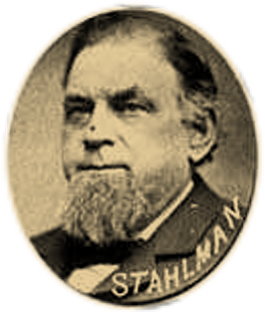Friday, June 19, 1829 Christopher Stahlmann
Christopher Stahlmann was born in Nürnberg, Bavaria to Conrad and Sabina Stahlmann. His father was a brewer, but his business failed during the bad harvests and the resulting economic recession of 1840s Germany.
Christopher emigrated to The New World in 1846 when he was 17 years of age. He was destitute and desperate, coming ashore with $5 in his pocket. He first sought opportunities in Indiana, then two years later he moved to Cincinnati, Ohio. He then spent some time in Muscatine, Iowa, where he met and married fellow German émigré Katharina Paulas.
In 1855 they headed north for the recently incorporated town of St. Paul, Minnesota. St. Paul was well situated at the confluence of the Minnesota and the Mississippi Rivers and had a large frontier military post called Fort Snelling. Stahlmann found a well-suited tract at the western edge of the city, just off a narrow wagon trail cutting through the wilderness called Fort Road. The plot had a pure water spring and natural limestone caves. These, along with the riverboat traffic and the ever-present soldiers from the fort made it a perfect location for a brewery.
Gray J. Brueggeman's excellent essay on St.Paul brewers "Beer Capital of the State - St. Paul's Historic Family Breweries" tells the rest of the story:
"Christopher Stahlmann was also engaged in a variety of other activities. He was a member of the state house of representatives (1871 and 1873), a Ramsey County commissioner (1871) and a director of St. Paul's National German American Bank (1883).
On December 3, 1883, at the height of his career, Christopher succumbed to tuberculosis. At the time of his death, his brewing operation was taking in a quarter of a million dollars a year. His plant had five three-story buildings with two large steam engines, three boilers, and a variety of small machinery spread out over 60 lots in St. Paul. They employed a workforce of forty-seven men. The inheritors of this thriving enterprise were his wife, Katherine, and their three sons, Christopher, Jr., Henry, and Bernard. All three sons were mature, experienced brewery workers, quite capable of carrying on their fathers' work. Chris and Henry had each served as the firm's treasurer, while Bernard had experience in a variety of clerical jobs.
Unfortunately, however, in a short period of time the same disease that killed their father would strike down every one of the Stahlmann brothers. Thus, tuberculosis claimed the lives of 31-year-old George and 26-year-old Bernard in 1887 and of Christopher, Jr., in 1894.
During this difficult disruptive decade, the brewery's presidency fell into the hands of Henry's father-in-law, George Mitsch, Jr. (1854-1895), a native of Germany and the founder of St. Paul's Catholic Aid Society. Mitsch, a blacksmith by trade and a druggist by desire (as well as a former legislator and councilman), was unable to lead the brewery through the disaster of losing four key executives. In 1897, the once-great Stahlmann Brewing Company went bankrupt and its last president, Charles J. Dorniden, had to sell the plant to a new enterprise, The St. Paul Brewing Company. The company existed only three years, for in 1900 the entire facility, including the beautiful stone mansion of Christopher Stahlmann at 855 West Seventh Street, was sold to the Jacob Schmidt Brewery."
Learn more at the links below
Associated Breweries
Jacob Schmidt Brewing Company of Saint Paul, Minnesota, USAIf you see an error, please correct me. Contribute corrections, images and additional information by following the contact link. Contact
Tavern Trove seeks images and facsimiles of signatures of America’s Pioneer Brewers so as to better tell their stories. We offer honest prices for ANYTHING associated with America’s brewing history, from the beautiful to the mundane. Let us know what you have through the contact link above.



